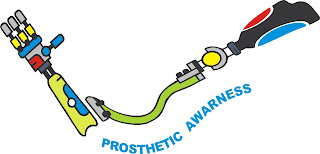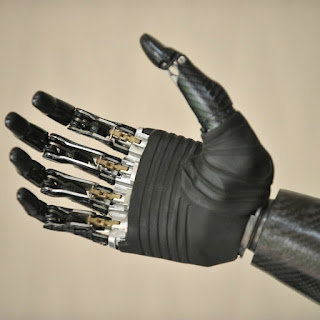Using a Prosthetic Device
Prostheses Parts and Types
There is a wide variety of prostheses
that are designed to function -- and in many cases look -- like a natural arm,
leg, hand, or foot. Although there are many different designs, most have
similar parts. These include:
- A socket into which the stump of
the amputated limb fits
- The suspension, which holds the
prosthesis onto the stump
- The shaft
- The foot, hand, or hook
- A covering for cosmetic
appearances
The socket is often lined with foam or
silicone to protect the stump. Special socks are also worn over the stump to
ensure a proper fit and improve comfort.
Following are some of the most common
types of prostheses:
Lower leg and foot. A number of prosthetic feet are
available to simulate the action of a natural foot after an amputation below
the knee. At least one available foot-ankle prosthesis is controlled by a
microprocessor. It uses feedback from sensors to adjust joint movement, making
walking more efficient and reducing the risk of falls.
Leg with knee. For amputations above the knee, the prosthesis has both a
knee and ankle joint. Currently there are more than 100 prosthetic ankle, foot,
and knee models. Some use fluid or hydraulic-controlled devices that let users
vary their walking speed. Others use computerized parts that let the user make
rapid real-time adjustments while walking.
Arm and hand. The oldest and most commonly used
prosthetic arm is operated with the body's own movements and a harness that
extends in a figure eight across the back and under the opposite arm. Others
use a rechargeable battery to run small motors in the prosthetic hand or hook.
The battery improves grip strength.
Choosing and Using a Prosthesis
A number of factors are involved in
choosing a prosthesis. They include:
- The location and level of the
amputation
- The condition of the remaining
limb
- Your activity level, particularly
for a prosthetic leg or foot
- Your specific goals and needs
Prostheses are designed and fitted by a
specialist called a prosthetist. The fitting process may begin in the hospital
shortly after amputation after the swelling has gone and down and the incision is
healed. It involves:
- Measuring the stump and the
healthy opposite limb
- Fitting silicone liner
- Making a plaster mold
- Fashioning the socket
- Forming the plastic parts and then
creating the metal parts of the limb
- Attaching the shaft
- Aligning the prosthesis
Depending on your comfort and how well
your wound is healing, you may begin to practice with your artificial limb as
early as a few weeks after surgery. A physical or occupational therapist
will train you on how to use and care for it.
CONTINUE READING BELOW
Prosthetic Comfort and Care
To gain the greatest benefits of the
new limb and help prevent problems, it is important to take care of the device,
the amputation site, and your general health by doing the following every day:
- Remove the prosthesis before going
to bed. Examine the device for loose parts or damage. Examine the stump
for blisters or other signs of
irritation.
- Clean and put a small amount of
lotion on the stump and massage the skin.
- Place a bandage on the stump to
decrease swelling when you are not wearing the prosthesis.
- Regularly inspect the skin of the
stump to look for sores or wounds. You may need to have someone else help
you look or use a mirror.
- Practice exercises recommended by
your physical therapist. These will include exercises for stretching, range of motion, body
positioning, and endurance.
- For leg prostheses, wear proper
fitting shoes and never change the height of your heels. The prosthesis is
designed for one heel height only.
- Clean the prosthesis' socket with
soap and water.
- Wear clean dry socks with the
prosthesis.
It is also important to maintain a
stable body weight. This will help to keep the
prosthesis fitting properly. You should also have the prosthesis examined and
serviced once a year to make sure it is in proper working order.
WebMD Medical Reference


%20(1).jpeg)


Comments
Post a Comment